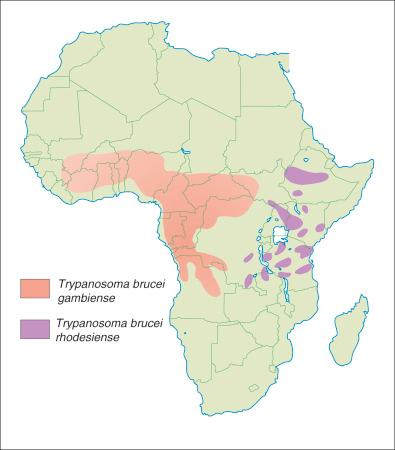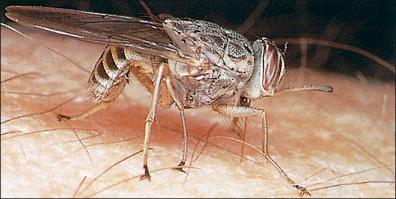Physical Address
304 North Cardinal St.
Dorchester Center, MA 02124
Also known as sleeping sickness, African trypanosomiasis is an acute and chronic disease caused by a parasite called Trypanosoma brucei , which is transmitted by the tsetse flies.
Recent travel to endemic areas of Africa should lead physicians to consider African trypanosomiasis in individuals presenting with acute febrile illnesses. The three most specific signs include the chancre (first stage), the targetoid macular trypanid (second stage), and Kerandel's deep delayed hyperesthesia (third stage).
Most patients recover after treatment with eflornithine, suramin, or pentamidine for hemolymphatic disease. Lumbar punctures should be performed at 6-month intervals for 2 years. Melarsoprol should be initiated as soon as signs of central nervous system (CNS) invasion are found. If therapy is started late, or not started at all, irreversible brain damage or death will occur.
American trypanosomiasis or Chagas disease is caused by the flagellate Trypanosoma cruzi , a protozoan parasite of humans, as well as wild and domestic animals. T. cruzi infection occurs commonly in rural areas of tropical zones of the Americas and is transmitted by many species of triatomine bugs that become infected by ingesting blood from infected animals or humans. In many countries of Latin America, especially South America, Chagas disease is the most important etiology of heart disease.
Chagas disease therapy is unsatisfactory. Even proper treatment, in the chronic phase, does not alter the serologic reaction or the cardiac function, although it usually cures the patient in the acute stage.
Protozoa of the genus Trypanosoma are responsible for the widespread tropical disease trypanosomiasis. There are African and American forms and they are considered endemic in some regions of these continents.
African trypanosomiasis, sleeping sickness
Exposure to tsetse flies.
Fever, headache, joint pain, skin rash, lymph node enlargement, skin rash, anemia, and weight loss in the hemolymphatic stage.
Motor and sensory disorders, sleep cycle alteration, white cells, and protein increase in the meningoencephalitic stage.
Also known as sleeping sickness, African trypanosomiasis is an acute and chronic disease caused by a parasite called Trypanosoma brucei . The parasites are transmitted to humans through the bite of tsetse flies ( Glossina spp.) in some regions of Africa.
Although confined to the African continent, in this time when air travel is continuously increasing, all dermatologists should know the cutaneous manifestations and be aware of the diagnostic tests for African trypanosomiasis, so that prompt diagnosis and proper treatment may follow.
The first references to sleeping sickness in Western Africa are from 1734, by Atkins, and tell of somnolence, dementia, and death. Nepveu (in 1890) found, for the first time, trypanosomes in the blood of a patient in Argel, but did not relate this finding to the disease. Forde and Dutton (in 1901, 1902) observed, for the first time, trypanosomes in the blood of a patient with irregular fever in Gambia ( T. gambiense ). The following year, Castellani identified the same parasite in the cerebrospinal fluid (CSF) of a sleeping-sickness patient in Uganda ( T. ugandense ). In 1903, Bruce and Nabarro demonstrated the disease transmission by flies of the genus Glossina . In 1910, Stephens and Fantham found another species of trypanosome in Rhodesia, and named it T. rhodesiense . Finally, in 1912 Kinghorn and Yorke showed that the T. rhodesiense transmission was due to bites of tsetse flies of the genus Glossina .
African trypanosomiasis is estimated to infect more than 20 000 and kill more than 5000 Africans annually, representing a risk to more than 50 million people who live near the vector. Approximately 6.5 million square kilometers in Africa remain unpopulated because of the presence of the infection, resulting in a heavy economic burden. The disease is confined to the African continent and its main geographic distribution comprises Senegal, the south of Mali, Burkina Faso, Niger, Chad, the southeast of Sudan, Ethiopia, Angola, Botswana, Zimbabwe, and Mozambique ( Fig. 4-1 ). Occasional cases are also imported into countries where the parasite is not endemic. Age, sex, and race appear to have no influence on susceptibility to African trypanosomiasis.

T. brucei gambiense is found primarily in the west and central regions of sub-Saharan Africa. It primarily infects humans but there may be animal reservoirs, such as pigs, dogs, or sheep. Glossina palpalis , G. tachinoides , and G. fuscipes are the three main species of tsetse flies involved in the transmission of Gambian sleeping sickness.
The more virulent T. brucei rhodesiense is a parasite of wild game, therefore humans are only occasional hosts. It is found primarily in East Africa (from Ethiopia and eastern Uganda south to Zambia and Botswana). Flies of the G. morsitans group are responsible for Rhodesian sleeping sickness (including G. pallidipes and G. swynnertoni ). These flies strike individuals visiting an endemic area, such as herdsmen, hunters, photographers, and tourists in general.
Intrauterine transmission has been recorded infrequently. Preventive measures have involved the removal of entire villages to tsetse-free land and mass treatment.
Trypanosomes are hemoflagellates that belong to the Salivaria family, Trypanosoma genus, and T. brucei species. There are three subspecies: T. brucei gambiense , T. brucei rhodesiense , and T. brucei brucei . The first two are responsible for African trypanosomiasis in humans, whereas the third one is an agent of animal trypanosomiasis (nagana). In the peripheral blood of humans, trypanosomes vary in length from 10 to 40 mm. The different subspecies of T. brucei can be distinguished by differences in pathogenicity for certain animals, electrophoresis, and DNA hybridization.
T. brucei is transmitted by the tsetse fly Glossina ( Fig. 4-2 ), within which it undergoes several developmental changes. During the bite of an infected animal or human host, trypomastigotes are ingested and rapidly differentiate into procyclic forms, in the insect midgut, by losing their antigenic surface coats. After 15–20 days of multiplication, these non-infectious epimastigotes migrate to the tsetse fly salivary glands and change morphologically into infectious metacyclic forms. When injected into humans, these metacyclic forms multiply and mature, in about 10 days, in the connective tissue and blood. From the skin, where they produce a local chancre, trypanosomes travel to lymph nodes, where they stimulate antibody production (and enlargement of these nodes). They alter the composition of their surface glycoproteins continuously in order to escape the host immune response. Transmission can also occur via blood transfusion.

Tissue damage is induced by either toxin production or immune complex reaction with release of proteolytic enzymes. Immune complexes have been demonstrated in both the circulation and the target organs of infected patients. Autoantibodies are frequently directed against antigen components of red cells, brain, and heart. Anemia due to hemolysis can result in further tissue destruction. Thus the initial response to the infection can result in febrile episodes, lymph node enlargement, myocardial and pericardial inflammation, anemia, thrombocytopenia, disseminated intravascular coagulation (DIC), and renal insufficiency in the acute stage of the infection.
CNS changes are most prominent in cases of T. brucei gambiense disease. They occur 3–18 months after the infection and consist of infiltrations in the meninges with lymphocytes, plasma cells, and morular cells. Morular cells are modified plasma cells with granular inclusions (immunoglobulins). Neurons undergo variable degeneration with myelin destruction and diffuse glial reaction. Meningeal lesions are usually represented by a diffuse leptomeningitis with congestion, edema, and microhemorrhages.
Become a Clinical Tree membership for Full access and enjoy Unlimited articles
If you are a member. Log in here